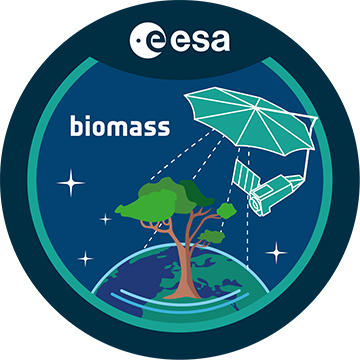1. Introduction
Listen to the Podcast
The demand for accurate Earth observation data is steadily increasing. Such data are essential for monitoring environmental changes, managing natural resources, and understanding climate change. Radar remote sensing systems, particularly Synthetic Aperture Radar (SAR), operate across various frequency bands, including X-, C-, L-, and P-band. The P-band, which operates around 435 MHz, is especially well-suited for retrieving information on vegetation structure and forest biomass. These capabilities enable in-depth analyses of ecosystems, especially tropical rainforests, which play a crucial role in the global carbon cycle. However, operating SAR systems in the P-band is increasingly challenged by Radio Frequency Interference (RFI). These disturbances not only degrade data quality but can also render entire observation areas unusable. The ESA BIOMASS mission, which operates in the P-band, faces specific challenges, including restrictions imposed by the U.S. Space Object Tracking Radar (SOTR). These restrictions have led to the definition of a global acquisition mask, which limits the mission’s operational capabilities and necessitates meticulous mission planning.
2. What is Radio Frequency Interference (RFI)?
2.1 Definition and Sources of RFI
RFI refers to disturbances in radar or communication systems caused by unwanted signals within the same or adjacent frequency bands. These disturbances can be unintentional, such as those from civilian communication systems, or intentional, as in the case of military jamming. The P-band is particularly susceptible to interference because it overlaps with frequency ranges used by terrestrial radar systems, telecommunications, and military applications. Furthermore, national regulations on frequency usage vary, complicating international coordination and increasing the risk of interference.
2.2 Impact of RFI on P-band SAR Systems
P-band radar systems are vulnerable to interference because they operate in a highly congested frequency range. Common sources of RFI at P-band include:
- Air traffic control and weather radars
- Telecommunication services such as mobile networks and satellite communications
- Military radar systems for airspace surveillance and missile early warning
RFI severely affects data quality. It leads to reduced radiometric accuracy, degraded phase stability, increased noise levels, and gaps in datasets. These disruptions complicate the interpretation of SAR imagery and can render InSAR analyses for monitoring ground movements or biomass changes impossible. For the ESA BIOMASS mission, which aims to deliver precise global forest biomass maps, minimizing RFI is critical to achieving its scientific objectives.
3. The ESA BIOMASS Mission and the Use of P-band SAR
3.1 Objectives of the BIOMASS Mission
The BIOMASS mission is part of ESA’s Earth Explorer programme. Its primary objective is to provide reliable global data on above-ground forest biomass. The resulting data products are intended to support monitoring of the global carbon cycle and contribute to international initiatives such as REDD+ (Reducing Emissions from Deforestation and Forest Degradation). Additionally, the mission’s observations aim to enhance understanding of forest ecosystems and their responses to climate change.
3.2 Why Use P-band?
P-band was selected because:
- Its long wavelength (approximately 70 cm) enables penetration through dense vegetation layers, allowing for accurate assessment of wood volume and biomass.
- It provides signals sensitive to large tree structures and woody biomass, which is particularly valuable in tropical rainforests with high biomass density.
- It remains sensitive to forest structure and biomass variations, even in high-biomass forests where other frequencies like L-band reach their saturation limits.
However, the P-band also presents regulatory challenges, as it is reserved for military and security-critical radar systems. In addition, the limited availability of free frequency spectrum poses a significant challenge for future missions.
4. The U.S. Space Object Tracking Radar (SOTR)
4.1 Role of SOTR
The Space Object Tracking Radar (SOTR) is operated by the United States and is a central component of Space Situational Awareness (SSA). It monitors and tracks objects in low Earth orbit (LEO), including satellites and space debris. SOTR plays a vital role in detecting potential collision threats in orbit and supports the strategic surveillance capabilities of U.S. defense forces.
4.2 Why Does SOTR Affect the BIOMASS Mission?
Simultaneous use of the P-band by SOTR and BIOMASS leads to potential issues:
- Mutual Interference: BIOMASS radar signals could disrupt SOTR’s tracking capabilities and degrade the quality of its surveillance data.
- Security Concerns: Continuous radar activity from BIOMASS over sensitive regions is considered a security risk, as it could potentially reveal information about military operations.
As a result, the U.S. Department of Defense (DoD) has imposed specific operational restrictions on BIOMASS, resulting in a comprehensive global acquisition mask.
5. The Acquisition Mask and Operational Constraints
5.1 The Global Acquisition Mask
ESA and the U.S. DoD have agreed on a global acquisition mask for BIOMASS. This mask defines where and when the BIOMASS SAR system is permitted to operate. It includes both geographical and temporal restrictions to prevent frequency conflicts with SOTR operations.
5.2 Restricted Zones
- U.S. Territory and Strategically Important Areas: BIOMASS is prohibited from acquiring radar data over these areas. These include military testing ranges, spaceports, and territories of allied nations.
- Buffer Zones Around SOTR Installations: These zones often extend several hundred kilometers to prevent radar activation near critical infrastructure.
5.3 Implications for the Mission
- These restrictions limit global data coverage, particularly over forest-rich regions located within restricted areas. For example, high-resolution data for much of North America is unavailable.
- The resulting data gaps require alternative solutions such as modeling and data fusion with other satellite datasets.
- Mission planning must optimize the available observation windows and areas, often coordinating with other satellite constellations to ensure comprehensive data collection.
6. Mitigation Strategies and Future Perspectives
6.1 Addressing the Constraints
- Data Fusion: BIOMASS data can be combined with data from other satellite missions (e.g., GEDI LiDAR data, ALOS-2, NASA NISAR) to fill gaps and develop more comprehensive forest models.
- Modeling and Interpolation: Geostatistical methods and machine learning techniques are employed to estimate biomass in areas not directly observed.
- Regional Partnerships: Collaboration with national space agencies and research institutions can provide supplementary datasets and calibration information.
6.2 Future Perspectives for Upcoming Missions
- International Frequency Agreements: Promoting multilateral agreements through organizations like the ITU to ensure equitable and coordinated use of the frequency spectrum.
- Adaptive Systems: Developing radar systems with cognitive signal processing that can dynamically respond to interference and switch frequency bands or modulations in real time.
- Integrated Observation Strategies: Combining radar data with optical satellite systems (e.g., Sentinel-2, Landsat) and passive microwave missions (e.g., SMAP) to enhance data resilience and information density.
7. Conclusion
The ESA BIOMASS mission is a milestone in global forest biomass mapping and provides crucial insights into the global carbon cycle. Leveraging the unique capabilities of the P-band, it delivers detailed information on forest structures essential for conservation and sustainable forest management. However, Radio Frequency Interference (RFI) and restrictions imposed by the U.S. Space Object Tracking Radar (SOTR) have led to the implementation of a global acquisition mask, limiting data access and spatial coverage. Despite these challenges, international cooperation, innovative data fusion approaches, and technological advancements promise to ensure that BIOMASS makes valuable contributions to climate protection, biodiversity conservation, and scientific research.
Further Reading
- Carreiras, J. M., Quegan, S., Le Toan, T., Minh, D. H. T., Saatchi, S. S., Carvalhais, N., … & Scipal, K. (2017). Coverage of high biomass forests by the ESA BIOMASS mission under defense restrictions. Remote Sensing of Environment, 196, 154-162.
- Tao, M., Su, J., Huang, Y., & Wang, L. (2019). Mitigation of radio frequency interference in synthetic aperture radar data: Current status and future trends. Remote Sensing, 11(20), 2438.
- U.S. Missile Warning Radars Could Squelch ESA’s Proposed Biomass Mission
- Recommendation ITU-R RS.1260-2 (09/2017) Feasibility of sharing between active spaceborne sensors and other services in the range 420-470 MHz
- Biomass, E. S. A. (2012). Report for Mission Selection. An Earth Explorer to Observe Forest Biomass. Noordwijk, The Netherlands: SP-1324/1.



Responses